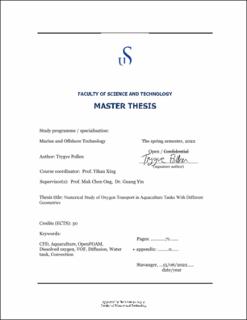| dc.description.abstract | The transport of dissolved oxygen concentration in water for aquaculture is a core parameter affecting
the quality of yielded fish. An emerging shift from offshore to land-based aquaculture presents advan-
tages to marine ecosystem sustainability and the maintenance fish health. One primary engineering
challenge of migrating aquaculture production to land-based facilities is developing sustainable aquatic
conditions for fish.
The objective of the present study is to use OpenFOAM CFD to simulate oxygen transport in differ-
ent water tank geometries based on the study performed by Yin et al. (2021) as a starting point. A
5.0m diameter circular tank geometry and three rounded square tank geometries with different corner
diameters (2.0m, 1.5m, 1.0m) are used in the study. The tanks are compared to see how the shape
of the tank influences the oxygen transport in the water. Numerical studies are performed using a
transient multi-phase CFD solver to obtain results for the four different geometries. The tanks are
filled with water until a steady state is reached for the oxygen concentration. Point measurements are
then extracted from the flow domain for comparing the spatial distribution of the diffused oxygen. The
results of the study show that the circular water tank geometry most suited at transporting diffused
oxygen in the water tank with steady radial water flow. The square tank geometries showed an overall
reduction in flow velocity in the flow domain which is further diminished with smaller corner radius.
Different with the circular geometry, the lack of rotational symmetry causes the momentum change of
the water to create skewed flow in the square tanks.
The circular geometry is considered in a mesh convergence study to determine an optimal mesh
resolution for the simulation. A validation study of oxygen transport in circular tank geometry is
conducted using experimental data for comparison. The comparison showed the numerical results to
have a maximum difference of 9% for probes close to the inlet.
Moreover, the results are valuable as a starting point for design of tank geometries and their abil-
ity to circulate oxygen in aquaculture tanks. The numerical results give an insight to the physical
quantities in the water flow which is important to consider in the selection of water tank designs for
land-based aquaculture. | |
